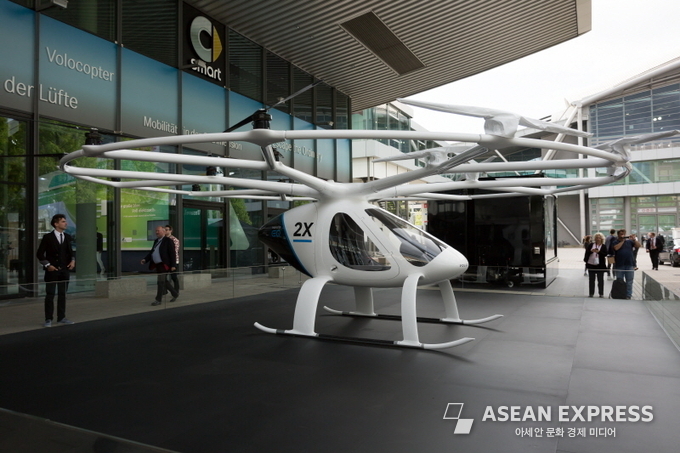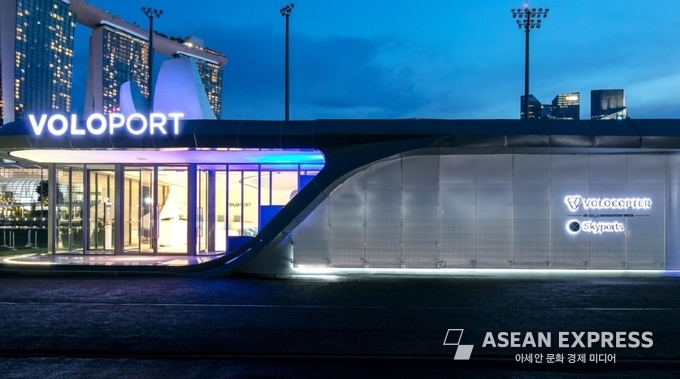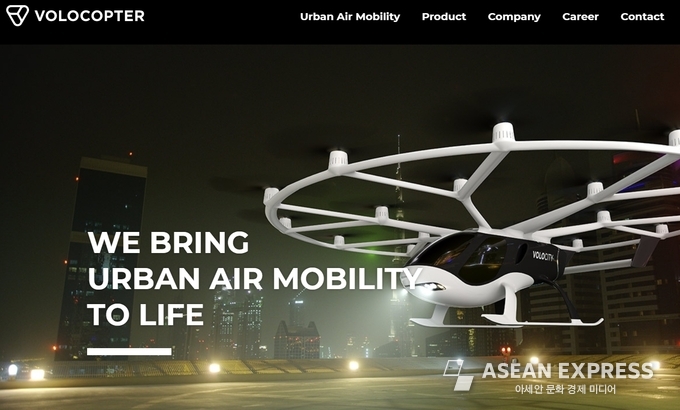■ 싱가포르 에어택시(볼로콥터) 시험 운행 '조롱' 대상?
자동차가 지난 20세기 가장 위대한 발명품 중 하나로 여겨졌다는 것을 부인하는 사람은 많지 않다.
1985년 칼 벤츠가 독일에 자신의 '가스파워 차량'을 특허신청했을 당시 이는 마차 운전자들에게 일종의 조롱의 대상이었다.
칼 벤츠와 그의 동료 발명가 다임러와 빌헬름 마이바흐가 함께 "내연기관 마차, 모델 1호"를 발명했을 때, 대다수는 여전히 완벽한 실패라고 보고 이를 장담할 정도였다. 어색한 모양의 강철로 된 마차는 역동적인 말이 이끄는 전통적인 마차보다 훨씬 느렸기 때문이다. 그런데 100년 만에 다시금 역사가 반복되는 모양새다.

■ 21세기 드론택시 '볼로콥터', 세계 최초 상업용 항공 택시 서비스 신호탄?
지난해 10월 싱가포르 "퍼스널 에어 모빌리티(Volocoptor)"가 마리나베이에서 시험 비행을 안전하게 끝마쳤다. 싱가포르 "볼로콥터"의 2X는 2인승 항공기로 독일의 드론에어로 기술을 기반으로 설계됐다.
현지 뉴스보도에 따르면, 이 비행은 성공적이었으며, 총 1.5km의 거리를 비행했으며, 마리나베이 지역 상공 40m의 평균 순항 높이에서도 2분간 지속되었다.
싱가포르 교통부와 싱가포르 민간항공청(CAAS)은 볼로콥터 등과의 기술 제휴에 따라 세계 최초의 상업용 항공 택시 서비스를 도시 상공에 도입할 수 있다는 강한 자신감을 보였다. 놀랍게도, 볼로콥터가 이렇게 의미 있는 진전을 이끌어내는 데는 3년이 걸리지 않았다.
게다가 볼로콥터와 기술 파트너 스카이포트는 마리나 베이의 플로팅 독에 최초의 볼로포트(VoloPort) 프로토타입을 제작하기도 했다. 볼로포트는 볼로콥터에 필요한 유일한 물리적 인프라로 알려져 있다. 볼로콥터는 매우 밀집된 중심 도시에서 운영을 시작하기 위한 승객 안전을 확보하기 위해 설계되었다.
그렇다면 어떻게 볼로콥터가 이런 진보를 이렇게 빨리 촉진시킬 수 있었을까?
결론부터 얘기하면 바로 싱가포르 정부의 뚜렷한 재정 지원이 있었다. 싱가포르는 지상의 교통에 의존에 설계된 기존의 규범에 충실하지 않고, 법적인 고민을 잠시 미루는 대신, 풍부한 예산을 지원하고, 해외 기술 파트너에게 사업 이익을 보장하는 방식을 택했다.
필자는 싱가포르 당국이 불필요한 규제를 없애는데 결정적인 역할을 했다고 감히 말할 수 있다. 겉보기에는, 그들은 공격적인 투자를 통해 국가의 발전을 우선시하면서 정책 실행을 방해하는 규제 억제를 좋아하지 않는다.
올해 6월, 한국 정부와 국토교통부는 서울에서 항공 택시 서비스를 상용화하기 위한 한국의 도시형 항공 모빌리티(K-UAM) 로드맵을 발표했다.
국토부에 따르면 5년 안에 비행 택시가 50km 거리인 인천공항에서 서울 여의지구까지 20분 이내에 도착할 수 있게 될 것으로 보인다. 지식경제부는 드론 기술 강화를 위해 공공, 민간, 학계 핵심 협력사 40여명으로 구성된 종합기술연구사업단 '더 UAM팀 코리아'를 발족하기도 했다.

■ 추격자 한국의 도전...도시형 항공 모빌리티 교통난 해소 돌파구
지금까지도 도시 3차원 교통의 이러한 변화는 그 효과의 불확실성으로 남아 있다. 각 국가는 개인 공중이동수단(또는 UAM)을 상용화하기 위해 성공을 위해 멀고 먼 여정을 떠난 셈이다. 대략 두 가지의 전략과 목적을 전제를 깔고 있는 셈이다.
첫째는, 항공 운송 기술에서 우위를 점하기
둘째는, 교통량 분산
항공모빌리티와 관련된 다양한 전문가들이 등장했음에도 불구하고 실현 가능성에 대해 많은 의구심이 나오고 있다. 한 저명한 국내 경제학자는 "도시 항공 모빌리티로의 급격한 전환은 예상치 못한 사회적 이슈 즉, 배치(택시, 버스 운전사), 건물에 둘러싸인 저고도에서의 항공 사고 등을 야기할 것"이라고 평가했다.
그가 옳을지도 모르지만 필자는 그런 의견에 반대한다. 다른 국가(또는 주권 국가) 간의 경쟁 기회에 의해 촉발된 "진정한 혁신"의 대부분은 엄청난 불확실성을 수반한다.
독일 벤츠가 만든 강철 바퀴 달린 마차의 개인 이동성 성공과 같이 생각되는 마차 운전자는 아무도 없을 것이다. 그리고 놀랍게도, 100년 이상 동안 우리는 여전히 그들에게 많이 의존하고 있다.
물론 규칙을 정립하고 있는 사람들(법률가)에게는 그러한 진보적 도전에 대한 더 많은 숙고가 필요하다. 상업성에 바탕을 둔 대중화에 관한 한, 그들의 올바른 결정은 진정으로 시민들의 편의를 창출하는 것이다. 개인용 항공기를 상용화하는 것은 행정적으로나 학술적으로 매우 어려운 과제가 될 수 있다.
필자가 볼 때, 도심속 에어 모빌리티는 도시 교통 문제를 해결하는데 실패한 어떤 시도보다 훨씬 더 가치가 있다. 독자분들이 어느쪽을 믿든지 간데 하늘 교통을 위한 전쟁은 이미 시작됐다. 만화에서만 봤던 진정한 가상현실이 현실로 다가오는 셈이다.
도시 항공 모빌리티 이해당사자들은 항상 먼저 우위를 점하는 사람들에게 관대했다. 한국 역시도 뒤늦게나마 에어택시 시장에 뛰어든 형국이다. 어떤 도시가 우위를 차지할 지도 관심사다.
필자인 김민수는 영국 런던 인도네시아 싱가포르 베트남 아랍에미레이트 등 다양한 도시에서 성장하며 각 도시의 특색을 좋아한다. 런던대 바틀렛 도시건설경영학을 전공하고 국내외 대기업 인프라분야 근무 경험을 바탕으로 현재 부산시에서 도시계획분야 정책연구원으로 근무중이다.

“Air Taxies”, Personal Aerial Vehicles to fly across advanced city skies in Asia
Not many deny Automobile is considered to be one of the greatest inventions in the last century.
When Carl Benz applied for German Patent with a new “Gas Power vehicle” in 1985, this was a target of mockery to carriage drivers. The majority still bet on perfect failure when Carl Benz and his great fellow inventors Gottlieb Daimler and Wilhelm Maybach altogether invented the “Motorized carriage, The Model No.1”; this was because this awkwardly shaped steel carriage was way slower than that of horse drown ones.
Last October, Singapore’s Personal Air Mobility (Volocoptor) has fully completed its test flights in Marina Bay. Singapore’s Volocopter’s 2X, a two-seated air vehicle, has been designed based on German Drone aero-technology.
According to local news reported, the flight was successful, flew a total distance of 1.5km, and also lasted for two minutes at an average cruising height of 40 m above the Marina Bay area.
Singaporean Ministry of Transport and the Civil Aviation Authority of Singapore (CAAS) has been demonstrated their strong confidence to bring the world’s first commercial air taxi services in city skies upon a technological partnership with Volocopter and many more.
Surprisingly, it didn’t take longer than 3 years for Volocoptor to draw such meaningful progress.
Furthermore, Volocopter and their technology partner Skyports built the first VoloPort prototype on the floating dock in Marina Bay. VoloPorts are known to be the only physical infrastructure required for Volocopter; designed to secure passenger safety to commence Volocoptor’s operations in highly densely crowded central city.
Then, How could Volocopter facilitate such progress so quickly? There was promising fiscal support from the Singaporean Government. Instead of sticking to existing norms on neither earth transportation concepts nor procrastinating due to legal issues, the Government proactively pushed forward with affluent budgets (support) and assuring business interests to foreign technology partners.
I dare to say Singaporean Authority was decisive to eliminate unnecessary regulation. Seemingly, they do not like regulatory inhibitors distracting policy implementation, prioritizing the nation’s advancement through aggressive investment.
In June, the South Korean Government, The Ministry of Land, Infrastructure, and Transport pronounced the Korean urban air mobility (K-UAM) roadmap to commercialize air taxi services in Seoul city. According to the Ministry, within 5 years, a flying taxi will be able to reach the Yeoui district, Seoul from Incheon Airport, a distance of 50 km, within 20 minutes by pilot services further aiming to begin a complete autonomous driven Air Taxi service. The ministry has launched a comprehensive technological research project team, “The UAM Team Korea” which consisted of 40 key partners from the public, private, and academic fields in order to reinforce Drone technology.
Up until now, such transformation in urban third-dimensional transportation still remains uncertain in its efficacy. Each countries journey for success to commercialize Personal Aerial Vehicle (or UAM) to
breakthrough.
A. Getting upper hands in air transportation technology
B. Traffic distribution
Despite the advent of tremendous innovation experts have many doubts about feasibility.
An eminent local economist said “ A radical transitions to an Urban Air Mobility will cause unexpected social issues collaterally i.e layouts (Taxi, Bus drivers), air crashes in low-altitudes in surrounded by buildings, etc..
He may be correct yet I am objected to him. Most of the “Genuine innovation” erupted by competitive opportunities between other countries (or sovereign states) entailed enormous uncertainty. None of the carriage drivers would ever be thought Carl Benz’s snail-like steel-wheeled carriages’ success in personal mobility. And not surprisingly, for more than 100 years we still rely a lot on them.
Of course, for those who are setting up the rules (lawmakers) requires more contemplation about such progressive challenge. When it comes to popularization based on commerciality, their right decision is what truly creates citizens’ convenience. Commercializing personal aerial vehicle schemes can be a very tough multidisciplinary challenge. From my point of view, Urban Air Mobility is worth much more than any attempt failed to solve city traffic problems.
Whether you believe it, this neck and neck air race has already begun. True virtual reality is coming true. Urban Air Mobility Stakeholders always have been generous to the ones getting an upper hand first. And both proud citizens are not very accustomed to losing their edge as well.
-END-









